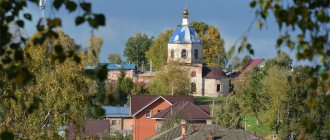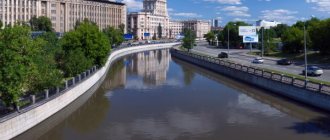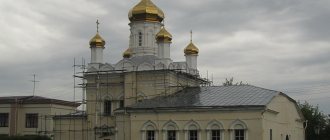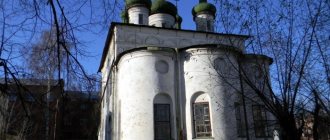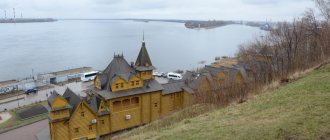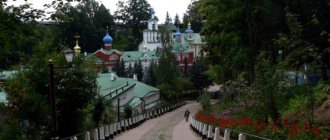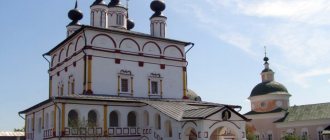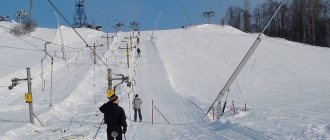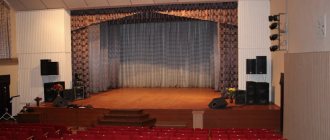Where is
Yegoryevsk is located 100 km southeast of Moscow. The city is located in the middle part of the Meshchera Plain, in the middle of the triangle formed by the Moscow, Oka and Klyazma rivers. The history of the city begins in the 15th century, during the reign of Prince Vasily the Dark. Well, it became famous in the 19th century, thanks to the philanthropist and mayor N. Bardygin.
In those days, the city was one of the most comfortable places in the Ryazan province. It is surprising that even during the reign of Soviet power, almost all ancient temples and cathedrals have retained their appearance to this day.
You can get to the city by public buses from Kotelniki station and by electric trains from the Kazansky station of the capital. The easiest way to get to your destination from Moscow is by electric train. Travel time will take about 2-3 hours, through 36 stopping stations. From the Yegoryevsk railway station you can walk to the city center or take a bus.
A little history about Yegoryevsk
Yegoryevsk is an ancient Russian city located near Moscow on the Guslitsa River. It is separated from the capital by only 101 km. You can cover this distance by car or bus in 2-3 hours.
This small town has a rich history. The village of Vysokoye was previously located in its place. There are records about him in documents of 1462 by Prince Vasily the Dark. One of the legends tells that at the beginning of the 14th century the people of the Chernigov gentleman Byakont settled in it. And in the papers of Ivan Kalita, the Guslitsky volost was mentioned back in 1328. Its location coincides with the current location of the Yegoryevsky district.
The name of the river means “witchcraft”. Translated from the ancient Slavic language “gusl” means “sorcerer”. It was believed that in the villages along the banks of the Guslitsa, residents were engaged in conspiracies.
Later Vysokoye was renamed Grigorievskoye. It was only in 1778 that it became a city. They named him Yegoryev in honor of Saint Yegory (aka St. George the Victorious). There is a more interesting version about the origin of its name. At one time, the borders of 3 principalities converged in the city: Moscow, Ryazan, Vladimir. When their envoys tried to receive tribute, they were told that they had already given it to another principality. This is how the residents managed to outwit all the messengers.
View of the old city
Yegoryevsky began to call it much later. Only 575 people lived in it, mostly small traders, artisans, day laborers, and merchants. The 19th century is the time of its heyday. Built at that time:
- Weaving manufactory by merchant Kartsev (1825).
- Paper spinning mill by the Khludov brothers (1847). Its buildings have survived to this day. The pride of the residents is the clock tower.
- Iron line to neighboring Voskresensk (1869).
During the same period, Yegoryevsk became the center of the Old Believers, since most of the population adhered to such views and traditions.
At the behest of Catherine II, a coat of arms and a development plan for the city appeared, which became famous for its annual grain fairs. Thanks to Catherine’s German meticulousness, the streets were laid out in such a way that they formed regular squares whenever possible.
According to the plan, the axial street was Moskovskaya (now Sovetskaya).
Nowadays in Yegoryevsk the city center has remained in the same form as it was formed at the end of the 19th and beginning of the 20th centuries.
Buildings with carved shutters and gates made of wood convey the historical appearance of the provincial town. New buildings are being erected closer to the outskirts.
Noticeable changes in Yegoryevsk occurred under mayor Bardygin. In the history of the city, this time was marked by the construction of:
- water supply;
- libraries;
- shopping establishments;
- Church of the Holy Trinity, and later a monastery.
There was lighting on the streets. His son also made his contribution to the development of Yegoryevsk. With his participation, a mechanical and electrical engineering school was built.
Anyone who enters the city, moving from Moscow, will see a famous monastery at the end of Vladimirskaya Street.
Weather, best time to travel
The climate in Yegoryevsk is quite mild and humid, typical for the entire Moscow region. The warmest period lasts from May to September, when northwest winds predominate, and winter is cold and snowy. At any time of the year, there are opportunities to spend an exciting weekend here.
In summer, amazing meadows give way to forest landscapes almost at the very edge of lakes and rivers. In autumn, pine forests are full of berries and mushrooms. During the snowy months, outdoor enthusiasts can enjoy winter sports and participate in folk festivals. And, of course, professional hunting and fishing exists here all year round.
Yegoryevsk - weather by month.
This convenient area, not far from the capital, attracts tourists with its clear, clean air, numerous forests, and landscapes created by nature itself.
Religious buildings
Yegoryevsk (attractions in the form of religious temples and ancient cathedrals with a complex history) is popular among believers as a holy place of pilgrimage and worship in front of the sacred relics of Orthodoxy.
Cathedral of St. Alexander Nevsky
The snow-white, majestic temple was built in 1877. Throughout its existence, the building served as a bell tower, a junior school, and a cinema in Soviet times. The building was revived as a temple in 1988, and then the paintings on the walls of the monastery were restored using old photographs and records from the archive.
Male Nikolo – Rodovitsky Monastery
The monastery itself was founded in the 15th century by the holy hieromonk Pachomius. It is located in the village of Rodovitsy on the outskirts of Meshchera near Moscow. From all over the country, pilgrims come here to touch the greatest shrine - the image of St. Nicholas the Wonderworker.
This unique relic of the monastery was hand-carved from a single apple tree after the appearance of the Wonderworker to the monastery minister. The temple is open to the public daily from 08:00 to 20:00. You can get here by bus from the city of Yegoryevsk.
Church of St. George the Victorious
One of the largest Old Believer churches in Russia is the Temple of St. George the Victorious, the creation of which was dedicated to the patron saint of the city in 1887. This is a very strong Orthodox Church, so pilgrimages are made here all year round. The temple managed to avoid destruction during the years of Soviet rule, but work is still ongoing on its restoration and restoration of the bell tower.
Attractions in the vicinity of Yegoryevsk
The outskirts of the city are also rich in attractive places. Let's look at the more interesting of them:
- Nikolo-Radovitsky Monastery in the village of Radovitsy was founded in 1584. Ivan the Terrible himself gave consent to its creation. This monastery was mentioned by Sergei Yesenin in the poem “Anna Snegina”. He visited there several times. The monastery was subjected to great destruction, so a global restoration was needed. His shrine is the image of St. Nicholas.
- In the village of Kolychevo, 16 km from the city, the Kazan Convent . Lovers of antiquity will be pleased with the visit. The originality of the architecture of the Kazan Cathedral, the Transfiguration Church, and the gate church of St. Juvenal attracts attention. Its creation was started by the monk Macarius, who bought the noble estate and organized a shelter in it. Orphans and rootless women were accepted there.
- Literally five kilometers from the city limits you can get acquainted with the Temple of the Sign . His story is again intertwined with the fate of the philanthropist Bardygin. It was he who sponsored its construction and decoration of the church premises. The interior decoration was luxurious. The church is active.
So you got acquainted with the sights of Yegoryevsk. We hope that our stories have helped you in planning your future itinerary for your planned trip. Having a plan in advance helps you save time while traveling.
The most interesting museums
In the Old Believer city of Russia there is only one official museum, but at the same time, it is one of the oldest museums in the Moscow region and is one of the 30 most famous European museums.
Historical and Art Museum of Yegoryevsk
The unique museum of the Moscow region was opened in 1911, with the help of local philanthropist M. Bardygin. Its collection is rich in rare treasures from past masters. Products made of porcelain, glass, painted wood, carved bone, unique Old Believer icons, sketches and picturesque collections of provincial merchant life in Russia were collected over four centuries.
Interesting exhibition designs and interactive installations create an unforgettable journey through the historical past. Museum workers invite everyone to theatrical excursions, master classes for adults and children, quests and dinners in the Fireplace Hall. The museum itself is located in a beautiful building, the former home of the Yegorievsky merchants Nikitins on Sovetskaya Street, 73/20.
House of Bardygin N.M.
A monument of artistic architecture of the 19th century, which remains the most beautiful building in Yegoryevsk and a representative of wealthy merchant houses of those times. The local landmark is made in several styles. The lower part of the building is made of stone, in an artistic style, the upper front part of the house is built in the Art Nouveau style.
A wide staircase leads to the main entrance, around which there is a well-kept garden. The house itself is surrounded by a wrought iron fence. The historical building has the status of a museum, where examples of the economy and life of wealthy merchants are preserved.
Yegoryevsk. Moscow region
Lacy towers and Gothic castles, strict socialist realism and bold street art, shy nuns and brave aviators... And all this in one city! We are going to Yegoryevsk near Moscow.
— Three hours on a good road (we are not street racers, the map is clickable), and here is the city of dreams, Yegoryevsk, born in 1778. For 70 thousand residents there are about a dozen factories, and a saleswoman in a roadside store, when asked “What interesting things do you have in the city besides Yegoryevsk sausages?”, without hesitation, answers: “Factory!” 
The myth about a large-scale industrial zone dispels as soon as we enter the city - the Gothic towers of an unknown castle suddenly “grow” to the left of the road. The only pity is that the sky is almost absent - no bright blue, no leaden clouds, no white lace. No artistry - just bare facts. But still impressive!
There is a “surveyor’s stamp” on the entrance gate. Moreover, this leveling sign dates back to 1875.
Above the entrance there is a promising sign: “YETI”. But there are no giant footprints of Bigfoot in the snow... Everything is prosaic: the Yegoryevsk Technological Institute is based in the castle.
At the beginning of the 20th century, the building housed a mechanical school named after Tsarevich Alexei. His trustee was Mikhail Nikiforovich Bardygin (a manufacturer and a very famous person in the city). It was he who made the first contribution to the construction in the amount of 200,000 rubles and in 1907 laid one of the first bricks in the foundation of the school.
At the end of the main building in the English Victorian Gothic style there was an inscription: “To my native Yegoryevsk - the Bardygins 1857-1907.” Alas, it was preserved only in archival documents and old photographs.
The then Chairman of the Council of Ministers, Pyotr Arkadyevich Stolypin, telegraphed: “I wish prosperity to the new useful hotbed of education, and to local leaders - vigor and energy for the benefit of our beloved Russia.” What good words! True, since that time the “hotbed of enlightenment” has become very worn out and requires restoration.
Next to the main building there is a whole Gothic quarter. Part of it is given over to various types of institutions, and part to residential buildings. Here, for example, just people live.
The entrance somehow reminded me of St. Petersburg... 
Wonderful backyard sheds with all the hallmarks of an architectural masterpiece.
with all the hallmarks of an architectural masterpiece.
Now try to guess what this mansion is used for?.. 
A rarity in every sense 
There are many imprints of the era of socialism in Yegoryevsk. On Sovetskaya Square (formerly Cathedral Square) there is a monument to Lenin from 1927. One of the few in the country that bears a portrait resemblance to the original. Experts say that the circulation of the monuments grew every year, but at the same time they lost their veracity. Lenin stands so highly that we were unable to appreciate his difference from our Tula one.
Locals joke that Ilyich points to the factory buildings of the cotton mill. They say everyone should go there. Which, in general, is not far from the truth: in Soviet times, almost the entire city managed to work at KhBK.
As it turned out, behind the abbreviation KhBK hides another nice Yegoryevsk castle. Moreover, it stands on the banks of the Guslitsa River, which gives it a special charm. Even in winter.
Moreover, it stands on the banks of the Guslitsa River, which gives it a special charm. Even in winter.
This English-style building appeared in the city thanks to the merchants the Khludov brothers in 1845 and was given over to a paper spinning factory. At that time, there were practically no spinning factories in Russia, and all yarn was purchased in England. About three thousand people worked at the factory.
In 1918, the Khludovskaya paper spinning mill was nationalized and renamed “Leader of the Proletariat”. The Order of the Red Banner of Labor in front of the entrance testifies to the labor exploits of its workers.
“Egorievsky Big Ben” is what locals call this architectural miracle. We still don’t understand how the clock on the tower works :))) Most likely, not at all. The photo was taken at 16.30.
Big Ben is visible from almost all points of the city. Exact address: st. Paris Commune, 1-b. Part of the factory is still occupied by the Yegoryevskaya Textile Manufactory, and part is rented out.
In 1895, the Khludov public school was built next to the factory. Now it houses the St. George Humanitarian Gymnasium. And she looks sad.
Only the coat of arms above the entrance betrays its former greatness. No other way than Gzhel. The topic will be to say that the city is named in honor of St. Yegori, that is, St. George the Victorious.
There is another version of the origin of the city’s name. Very funny. Since the ancient settlement was located on the border of three principalities - Moscow, Ryazan and Vladimir, people came to it for tribute from each.
So the residents successfully “out-foxed” all the tax collectors, declaring that everything had been paid yesterday and to the last penny. These are such great guys.
Across the road from the factory is another castle - the Prison Castle. A real fortress behind barbed wire. Pre-trial detention center No. 7.
In 1785, Catherine issued a Decree on the construction of a fort in the city of Yegoryevsk. At first the prison was wooden, but in 1865 it became stone. I'm sure there are many urban horror stories associated with it. The image obliges.
In the area of the factory there are two more architectural masterpieces - wooden ones at that! One is a former dispensary for workers (Telmana St., 10), built at the end of the 19th century (!).
Wooden two-story house in Art Nouveau style. It’s hard to imagine, but in the 1970s, about 1,300 people vacationed there annually without interruption from work and physical therapy.
The second masterpiece is a multi-entrance wooden house built in 1917 on the street. Telmana, 3. Simply fantastic design!
It was not possible to photograph it completely, because it resembles a multi-colored caterpillar huddled in the opening between the barns.
Wooden, long, two-story, with porches of different styles. There are 15 apartments in the building and each has its own entrance. From the street side there are entrances only to the second floor...
...from the side of the yard - only on the first one.
The house is still inhabited. And none of the residents wants to move, despite the merciless city program “the house is scrapped, all residents are moved to new buildings.” I wouldn't want it either.
Just think, these logs are almost 100 years old!
Closing the topic of Yegoryevsk wooden architecture, I will say that there are a lot of wooden houses in the city, all of them are interesting - with lace trim, carved mezzanines and for some reason most of them are red-brown in color. It's interesting to walk.
In small provincial Yegoryevsk, there was also some cool street art. For example, in the courtyard of house 48 on the street. The seller of magic pigeons lives in the Soviet Union. Nationality is guessed.
For example, in the courtyard of house 48 on the street. The seller of magic pigeons lives in the Soviet Union. Nationality is guessed.
Next door to him lives a janitor with the face of one who must not be named...
...and the sweetest couple, beaten by life.
But most of the graffiti in Yegoryevsk are pictures about the adventures of a carton of milk and bear the signature of Milk. At first it makes you happy, but then you realize that you will leave, but you will never be the same again; the package has already crept into your subconscious :)))
With every step we never cease to be surprised. A “small Kremlin” suddenly appears in the center of the city. In fact, this is the Holy Trinity Mariinsky Convent (Vladimirskaya St., 2).
The monastery was opened on August 25, 1900 and its first abbess (until 1907) was Abbess Olympias (from the same Bardygin family).
After the revolution, all church valuables were confiscated, the monastery was closed, and 30 nuns and novices were sent to the Yegoryevsky prison castle. Later, both the bell tower and the five domes of the Trinity Church were demolished, since, according to city authorities, they disfigured the appearance of the city. In the early 1960s, the monastery cemetery was also razed to the ground... The temple was converted first into a museum, and then into a club, and a flight school was located on the territory of the monastery.
They are still neighbors - the convent and the Yegoryevsk Aviation Technical College named after Chkalov (the border is a brick wall and tall spruce trees).
By the way, the most famous graduate of this school is test pilot Valery Chkalov (and this was in 1922). The school itself is named in honor of him - Hero of the Soviet Union, commander of the aircraft crew who made the first non-stop flight over the North Pole from Moscow to Vancouver in 1937. There is a monument to the hero on the territory, but the only way to photograph it is through the monastery fence.
The revival of the monastery began on January 7, 2000, at the same time the first divine liturgy took place in the Trinity Church. And now the restoration is in full swing. And it pleases! Such beauty is saved 
In 2006, a women's community was reopened at the Trinity Church.
Future civil aviation specialists (young, beautiful and strong) are found very often on the streets of Yegoryevsk. So, if anyone is dreaming, welcome to the city of free romantics. They are there in droves!
So, if anyone is dreaming, welcome to the city of free romantics. They are there in droves!
Another celebrity associated with Yegoryevsk is Eduard Uspensky, “the father of Cheburashka” and the author of a huge number of children’s books that we grew up with. Uspensky was born here! Yegoryevsk residents are proud of this fact, but for some reason there is no monument to the legendary cartoon character in the city. It is located in neighboring Ramenskoye (70 km).
But other sculptures are held in high esteem in the city. Opposite Alexander Nevsky Square is the “Iron Lady” (that’s what they call her). Strange woman, strange... It’s not clear where the lady holds her hands, where she sucks her mouth and whether she has a heart? Some kind of soulless frame (I have one such friend). And what is logical is that people constantly drink and drink next to her! (judging by the bottles lying around).
The “Monument to the Basket” stands in the park at the intersection of Sovetskaya and Tupitsyn streets. As they say, the only one in the world. I don’t doubt this for a minute :)))) I wouldn’t call it a monument at all - just an ordinary flower garden, an element of landscape design. But the trick is different!
Just a couple of years ago, in this very place there was a rare sculptural composition “Lenin with a Soldier and a Sailor” (popularly “For Three”). Now it can be seen at a gas station near the Shiryaevsky Bridge. It’s good that they saved it at all. The photo, alas, is not mine. Photo by Alexander a ac1950.
And finally! Yegoryevsk is famous for its “Museum of Curiosities” (according to documents, it passes as the Yegoryevsk Historical and Art Museum, in 2010 it was among the 30 best museums in Europe). Here I am shedding tears - since we didn’t get to the museum
Here I am shedding tears - since we didn’t get to the museum
According to eyewitnesses, the walls of the museum are covered from floor to ceiling with traditional Guslitsky painting. The basis of the exhibition is the personal collection of the merchant Bardygin. The museum has a singing book, a magic mirror and a talking portrait of the famous soothsayer Ivan Koreysha, whom Tolstoy, Dostoevsky, Gogol and Leskov personally knew. Museum address: st. Sovetskaya, 73/20.
In the souvenir shop at the museum, I fell in love with a motor mouse. But I didn't buy it. Sorry, mouse.
I still have a funny set of postcards to remember about Yegoryevsk 
You can see the rest of the cute details not included in the story in the gallery.
How to get to Yegoryevsk by public transport:
- by bus No. 325 from the Vykhino metro station;
- from the Kazansky railway station in Moscow by train (directions Golutvin, Ryazan, Shifernaya) to the platform “88 km”, then by bus No. 29 to Yegoryevsk.
Want to share your “travel stories”? Write in a personal message to Tatyana Afanasyeva And long live our common endless and cheerful “Gulbari”!
Interesting places for a weekend route (close and wonderful!):
Avchurino Berendeyvo kingdom Bykovo Dmitrov Dubrovitsy Kiritsy Kozelsk Kolomenskoye Kolosovo Kubinka Kuskovo Marfino Melikhovo Nikola-Lenivets Tarusa Khruslovka Yaropolets
And to museums! (I suggest adding to the list). Museum of Optical Illusions
Gallery
show all photos
Survey
The strong side of Yegoryevsk, in your opinion, is...
Monuments and Monuments
Yegoryevsk (the sights in the form of memorial structures are not very diverse) offers to get acquainted with the most outstanding of them, which characterize the symbols and history of the development of the Old Russian region.
Monument to the basket
The monument symbolizes the prosperity and abundance of the city's inhabitants. The modern installation is made of metal in the form of a forged basket. The art object is installed on a pedestal on the territory of Peace Park.
The metal structure is believed to be one of a kind, immortalized in the image of a basket.
Jackhammer Monument
The symbol of mountain craft is made in the form of two rocks in a vertical position and massive stones at their feet, which are crushed by a powerful jackhammer. The monument is located at the entrance to the Phosphoritny microdistrict, 10 km from the center of Yegoryevsk, not far from the highway.
The landmark was erected in honor of workers mining and processing phosphorite in 1930, when deposits were first discovered here and the development of phosphorite, natural quarries began.
Sculpture to space explorers
At the intersection of Lenin Avenue and Sovetskaya Street, a monument was erected, which local residents call “Wing”. This place is dedicated to the Russian pilots who crashed during test flights and prevented the plane from falling on the city in 1977.
Yegoryevsk and Bardygins: for the benefit of the native city
Stories
October 13, 2021 4 minutes Author: Anna Geronimus 113
Ancient Yegoryevsk is located in the southeast of the Moscow region. You can get to it by train, which runs from the Kazansky railway station, or by bus 325 from the Kotelniki metro station. A lot of materials are devoted to the past of Yegoryevsk, but I would like to dwell on the history of the Bardygin family, which played a very important role in the life of the city.
print version all stories
Historical documents mention that Yegoryevsk was founded in the second half of the 16th century on the site of the village of Yegorie-Vysokoe (named after the parish church). In 1778 it became the city of Yegoryevsk.
One of the main city attractions today is the city’s historical and art museum, located on the former cathedral square in the mansion of the Nikitin merchants. This museum appeared in 1911 thanks to Mikhail Bardygin.
The building of the Historical and Art Museum in Yegoryevsk
The former estate of the Bardygin family is located on Oktyabrskaya Street. The house is not a centuries-old noble nest, and therefore reflects the tastes of the last owners. At the beginning of the 19th century, the estate was built with money from the Knyazev merchant family. Then, at the beginning of the 20th century, Mikhail Bardygin purchased it from the previous owners and underwent a major reconstruction. On the territory of the estate, a manor house, an outbuilding with a stable, a fence and a garden have been preserved to this day. The two-story mansion is one of the most beautiful buildings in Yegoryevsk.
On the second floor of the main house there were state rooms, elongated halls and a wide central staircase - the entire space was decorated in the fashion of the time in the Art Nouveau style. While walking around the estate, pay attention to the wrought iron fence around the front garden and the preserved brick wall with a wicket and gate running along the garden. In Yegoryevsk, on Sovetskaya Street, another merchant mansion, which belonged to the father of Mikhail Bardygin, has survived to this day.
The Bardygins were large textile manufacturers. They lived and worked according to the laws of that time: wasting money on entertainment was considered a sin, and therefore father and son preferred to spend their finances on charitable causes.
Nikifor Mikhailovich Bardygin was born and raised in a peasant family. His father, having moved to Yegoryevsk, took up trade, and young Nikifor helped him from childhood: he worked in the shop and at home, and went to Kolomna to buy flour. Gradually, the family's affairs went uphill. In the 50s of the 19th century, the family was elevated to the rank of merchants, and in the 1870s Nikifor Mikhailovich was elected mayor. During his reign, he brought order to the city: a water supply system was built here and lighting was installed. In the 1880s, Nikifor Mikhailovich built a textile factory (located on the current street of the Paris Commune). The red brick building is decorated with a clock tower, but, unfortunately, the local Big Ben is in terrible condition.
Nikifor Mikhailovich Bardygin
In addition to the factory building, the elder Bardygin built with his own money the Trinity-Mariinsky Monastery and the Church of Alexander Nevsky in Yegoryevsk. According to the memoirs of contemporaries, Bardygin Sr. was an intelligent and decent person who never betrayed people. It was he who was the first to lend a helping hand to the architect Alexander Kaminsky, who was fired due to the collapse of a house built according to his design. The architect Nikifor Mikhailovich, who found himself in a difficult situation, was entrusted with overseeing the construction of the Trinity-Mariinsky Monastery, thereby returning his good name.
After the death of N.M. Bardygin in 1901, his second son became his heir. Mikhail Nikiforovich, unlike his father, received an excellent education. In his adolescence, he studied at the local gymnasium, opened at the request of his father. After graduating from high school, young Bardygin was sent to study at the famous Moscow Katukov School named after Tsarevich Nikolai Alexandrovich. Afterwards, the young Bardygin continued his studies in Western Europe, and after returning to Russia, he took over the management of the family business. Having become the sole owner of the factory and trading establishments, Mikhail Nikiforovich established an industrial and commercial partnership.
Temple of Alexander Nevsky
In addition to entrepreneurial activities, Mikhail Bardygin was also involved in public life, becoming a member of the board of the Moscow Merchant Bank and a deputy of the Third State Duma from the Ryazan province. I would like to note that Mikhail Bardygin kept pace with the times. Over the years of his active entrepreneurial and social activities, he managed to build a comprehensive boarding-type Mechanical and Electrical Engineering School and a Women's School in Yegoryevsk. Again, according to the recollections of the Bardygin workers, because of the humane attitude of the owner towards them there were never strikes at the factory.
Mikhail Nikiforovich Bardygin
But, despite the creative deeds of the Bardygin family, the October Revolution did not spare them either. After the events of 1917, all the property of the Bardygins was nationalized, and Mikhail Nikiforovich himself was forced to emigrate to France with his family. They say that family business there was also going well and Mikhail Nikiforovich even opened a small textile enterprise.
In 1933, M.N. Bardygin died. He was buried in Nice, where his wife and children found their final resting place. And in Yegoryevsk, already in our time, opposite the Alexander Nevsky Church, a monument to him was erected by grateful townspeople.
The human soul is infinite, and the stones of Yegoryevsk preserve the historical memory of those who made its glory. That is why you can peer endlessly at the outlines of the city, guessing behind them those without whom Russian history is unthinkable.
Photo: photobank of the Moscow region, hram-gorki.cerkov.ru
Share:
Architectural structures
Yegoryevsk (sights in the form of architectural structures that were formed over the course of a century) offers to see echoes of the urban planning reform of Catherine II with some elements of English Gothic.
Ruins of Khmelnytsia
In the area of the city, among the fields, stands an original building. According to local residents, hops were grown, dried and ground in these areas. The local attraction is very popular among tourists who love unusual photographs.
The tower is located near the village of Ryazanovskoye on Yegoryevskoye Highway.
Ensemble of the central square
The most historical part of the city, which served the townspeople as a gathering place, festivities and trade in the pre-revolutionary period. Interesting: in 1826, the Assumption Cathedral was built on the square. Construction of the temple lasted about 12 years.
Later, it was blown up by order of the Soviet authorities and for another 12 years, the stones and remains of the shrine were removed. Along the perimeter of the square, buildings from the late 19th century - church shops - have been preserved. Nowadays, there are many souvenir shops and cafes located here.
Khludov Factory
The first spinning mill was built in 1845 by the Khludov brothers. Woven yarn was famous not only in Russia, but also abroad, so production expanded and flourished. Not far from the factory, in 1862, a living quarters for workers was built, and next to it was the Church of St. Michael the Archangel.
In 1870, the manufactory was retrained for weaving production, and a little later a paper spinning workshop was opened here.
The complex of buildings was constantly restored, so it is well preserved to this day. Today, it is a kind of museum of industrial buildings of past times, which were planned in the English spirit, and the central tower is reminiscent in style of Big Ben in London.
Mechanical and Electrical Engineering School
Profsoyuznaya Street runs perpendicular to Sovetskaya. It’s worth walking along it because of the beautiful architectural structure – the Mechanical and Electrical Engineering School. It was erected in 1909 under the leadership of the Moscow architect Baryutin.
The appearance of the building is reminiscent of Oxford colleges or a medieval castle with turrets
The founder of the school, Mikhail Bardygin, sought to attract first-class specialists and use the best materials. New machines were purchased in Germany, teachers were trained abroad.
The project included the construction of buildings for students and teachers, and the creation of a garden with a pond.
Now it houses the Yegoryevsk Technical Institute.
Natural attractions
The squares and parks that decorate Yegoryevsk are much younger than the city itself. All of them were created at the end of the 19th century.
Bardyginsky garden
In 1875, the mayor N. Bardygin laid the foundation for the construction of the first park on the site of the old horse square. For a century, the square functioned as a place for public festivities. Today, a variety of sporting events and entertainment shows and programs are held here. The central park has children's attractions, fountains, well-groomed alleys and many flower arrangements.
Park "200 years of Yegoryevsk"
For many years the park was in disrepair, and only in 2015 work began on its improvement. The total area of the park is 25 hectares. There are recreation areas with benches, children's playgrounds and fountains, and themed alleys.
The park is equipped with lighting and video surveillance, there are pedestrian sidewalks and bicycle paths, and a young apple orchard has been planted. In the near future it is planned to create a skatepark and an amusement park.
Guslitsa River
The region of the Moscow region has preserved its natural landscapes almost in their original form. Mixed and coniferous forests, vast swampy areas, numerous lakes and rivers deserve special attention. The Guslitsa River is considered one of the natural attractions of the city.
In addition to the wonderful views among the pine forest, this is a favorite place for avid fishermen. Recreation centers are conveniently located along the river, where you can have an acceptable and comfortable rest for the whole family in nature.
Live in Yegoryevsk: be a provincial blogger and be proud of brands
Yegoryevsk near Moscow celebrated its 240th birthday in 2021. Despite the distance from Moscow, the city is recognized as one of the most comfortable in the region, the city museum is considered one of the best in the region, and the brands of Yegoryevsk are known throughout the country. A native resident of Yegoryevsk, blogger Marina Kuznetsova told RIAMO about what places in the city remind her of Europe, and how Egoryevsk bloggers differ from Moscow ones.
Moscow Region Europe
View this post on Instagram
Publication from MY MAGAZINE ᴍᴀʀɪɴᴀ ᴋᴜᴢɴᴇᴛsᴏᴠᴀ

